TL;DR: At a glance, canoes are generally larger, with an open design and wider hull that makes it more stable than kayaks, but the smaller frame of kayaks makes them easier to manuver. Here are the key takeaways from my Canoe vs. Kayak review:
- Canoes are generally more stable due to their wider hulls.
- Kayaks are easier to paddle straight and turn/maneuver than canoes.
- Canoes have more open interior space for gear storage than kayaks.
- It’s easier to get in and out of a canoe than a kayak due to the open design.
- Canoes tend to be more expensive than kayaks on average.
When it comes to paddle craft, there is one looming question. Should I get a kayak or a canoe? What are the differences, anyway?
Before I got into water sports, I was intimidated by all the jargon. I didn’t know my bow from my stern, let alone the pros and cons of a planning hull vs. a V-chine hull.
Now that I’ve spent a few years playing around on different boats, I feel more comfortable navigating the ins and outs of kayaks vs. canoes.
Spoiler alert: canoes have way more benefits than you might think!
So, while your initial instinct might be to get a kayak because they’re so “sexy,” stay put and listen to what I have to say about both before you make your choice.
Note: this article contains affiliate links, which help run this site at no extra cost to you so I can keep providing free travel advice and tips.
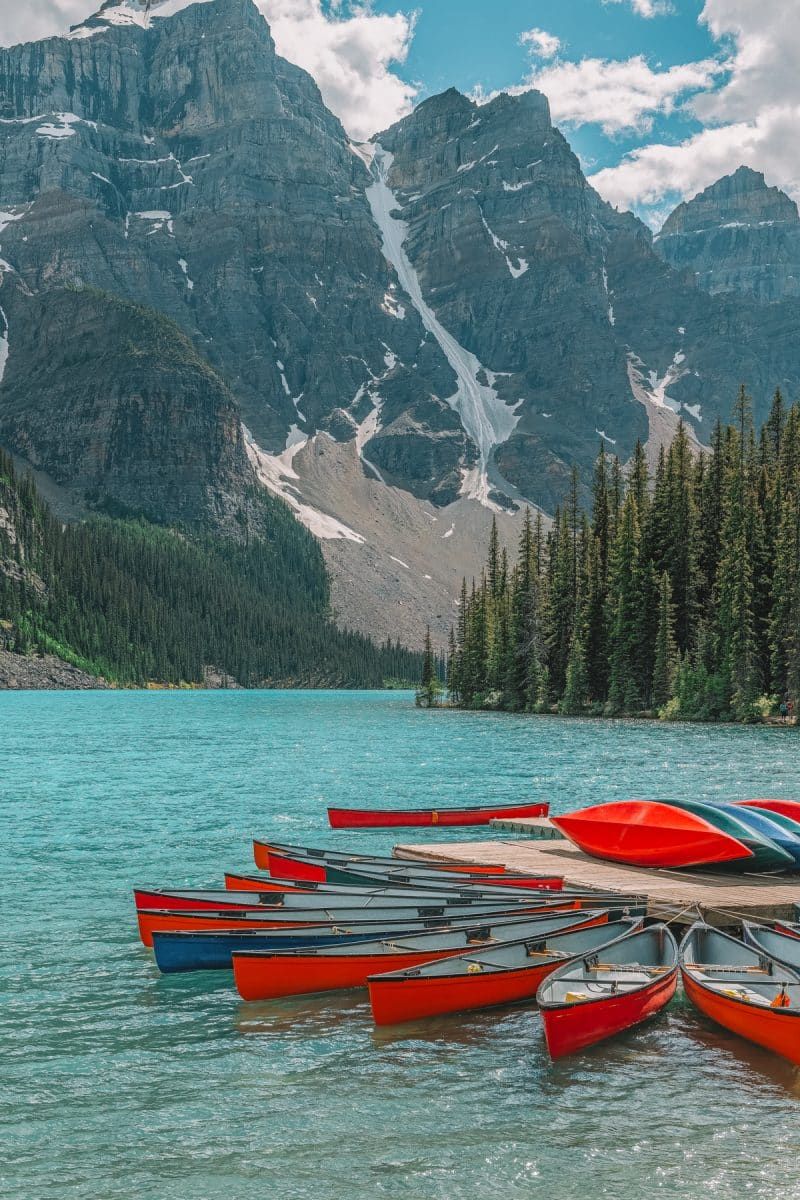
Kayak vs. Canoe: Main Differences
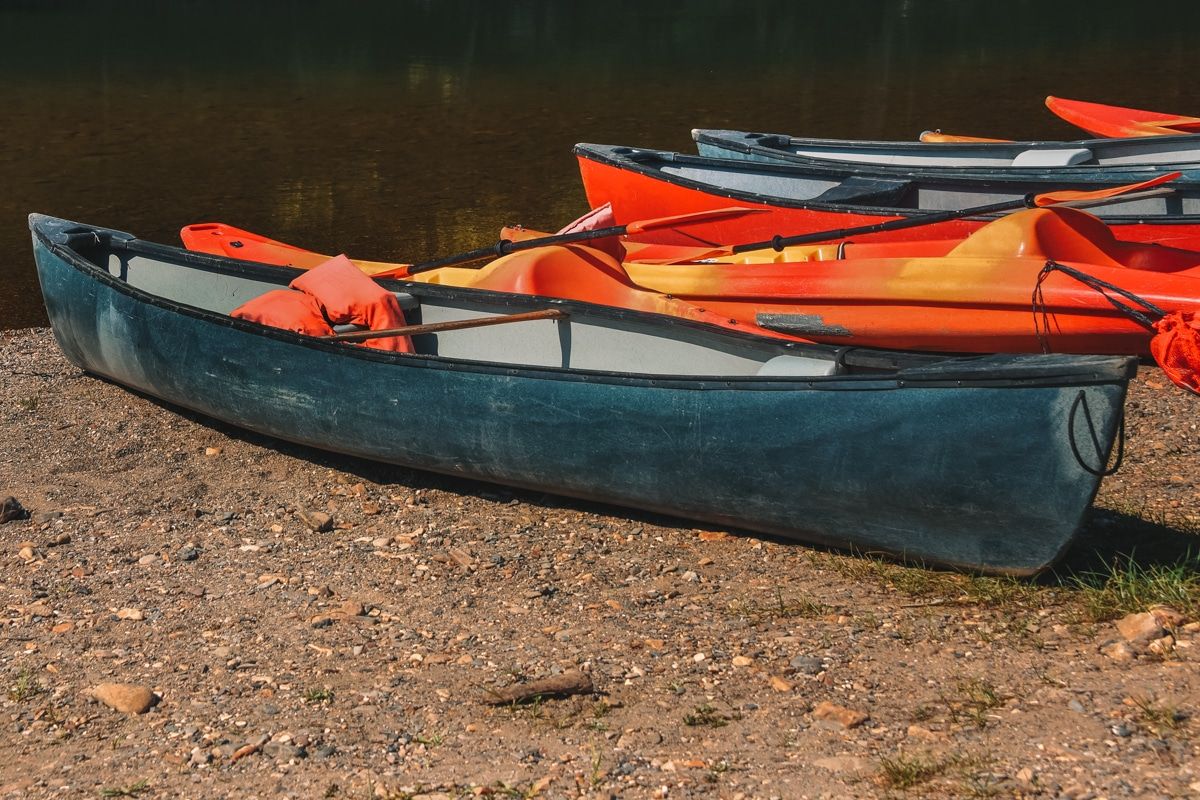
There are some general differences between kayaks vs. canoes.
But, keep in mind that there are so many different styles of both kayaks and canoes you could easily find an exception to all the guidelines I’m writing below.
For example, while kayaks are generally faster than canoes, a racing canoe would still be faster than a recreational, inflatable kayak.
Shape
A typical canoe is a rowing boat with higher sides and an open cockpit that’s bigger and broader than the average kayak.
By contrast, kayaks tend to be slimmer and have the option of an open or closed cockpit.
Stability
Because of its wide shape, the average canoe is a bit more stable than the average kayak.
Kayak stability varies widely based on the body and style of the kayak, but in general, they sit lower in the water than canoes and are slightly more prone to tipping.
Gear Storage
No two ways about it; most canoes have much more storage space than kayaks because of their open design.
You can comfortably fit lots of camping gear and even coolers in most canoes, making them a good choice for camping trips.
However, one benefit of kayak storage space is that it’s often enclosed, which helps keep your gear dry.
You can also purchase fishing kayaks, or even motorized fishing kayaks, designed with lots of open space on board if you’re looking for a kayak with lots of gear storage.
Consider investing in a dry bag or a waterproof duffel bag to make double-sure that your gear stays dry while paddling.
Maneuverability
Due to their larger size and flatter (planing) hull (bottom), canoes tend to be harder to keep in a straight line than kayaks.
It takes more physical exertion and coordination to paddle straight in a canoe vs. a kayak. If you’re looking to travel long distances, kayaks might be a better choice.
Kayaks also come in shorter sizes that are easier to maneuver in whitewater conditions.
That said, kayaks are usually easier to maneuver on calm water or slow rivers. If you’re in windy conditions, you may find it easier to paddle with a more stable boat and the second set of arms you’d have in a canoe.
Paddles

There is a distinct difference between a canoe paddle and a kayak paddle. Most kayakers use a double-bladed paddle, while a canoe paddle has a single blade and a T-knob on the end.
Stroke
To paddle a canoe, you take your single-bladed paddle with one hand on the T-knob and one in the middle of the paddle shaft.
You just alternate the paddle strokes from one side of the canoe to the other to maintain a straight line.
In contrast, you hold most kayak paddles in the middle of the shaft with your hands about shoulder-width apart.
The paddlers control the kayak by dipping the double-bladed paddle from side to side.
You could use a kayak paddle on a canoe if push came to shove, but you just wouldn’t be able to achieve proper paddling technique (which, at the end of the day, will help you stay comfortable).
Ease of Transport
Most canoes are heavier and larger than kayaks, so they’re a bit more challenging to transport.
That said, there are inflatable versions on the market that pack down into a duffel bag. Inflatable kayaks are much more common than canoes, though.
Check out our roundup of the best kayak racks for trucks if you’re looking for some guidance on moving your boat. All of these kayak racks will work for canoes too.
Getting In and Out
Some kayaks are tricky to get into, especially those you sit inside. With an enclosed cockpit, you must get your legs into a small space and outstretch before sitting down.
Unlike kayaks, canoes offer an easier way to get into and out of the boat. With a canoe, all you do is step inside, and you can usually use the high sides to help you stabilize yourself.
Seat Style
Whether you find canoe seats more comfortable than kayak seats is a personal preference.
Most canoe seats consist of a simple bench with no back support. The paddler sits or kneels wherever they like and in whichever direction, and this has its benefits.
By contrast, most kayaks’ seats offer some back support, and some are pretty comfortable. The tradeoff is that there are fewer options to move around (for sit-inside kayaks anyway).
Staying Dry
Sit-inside kayaks will keep you drier than canoes or sit-on-top kayaks. The spray skirts on sit-inside boats are great if your paddling trips take place on cold water or in cold weather.
Price
Generally speaking, canoes are more expensive, but exceptions exist that offer more canoe for your buck.
Types of Kayaks
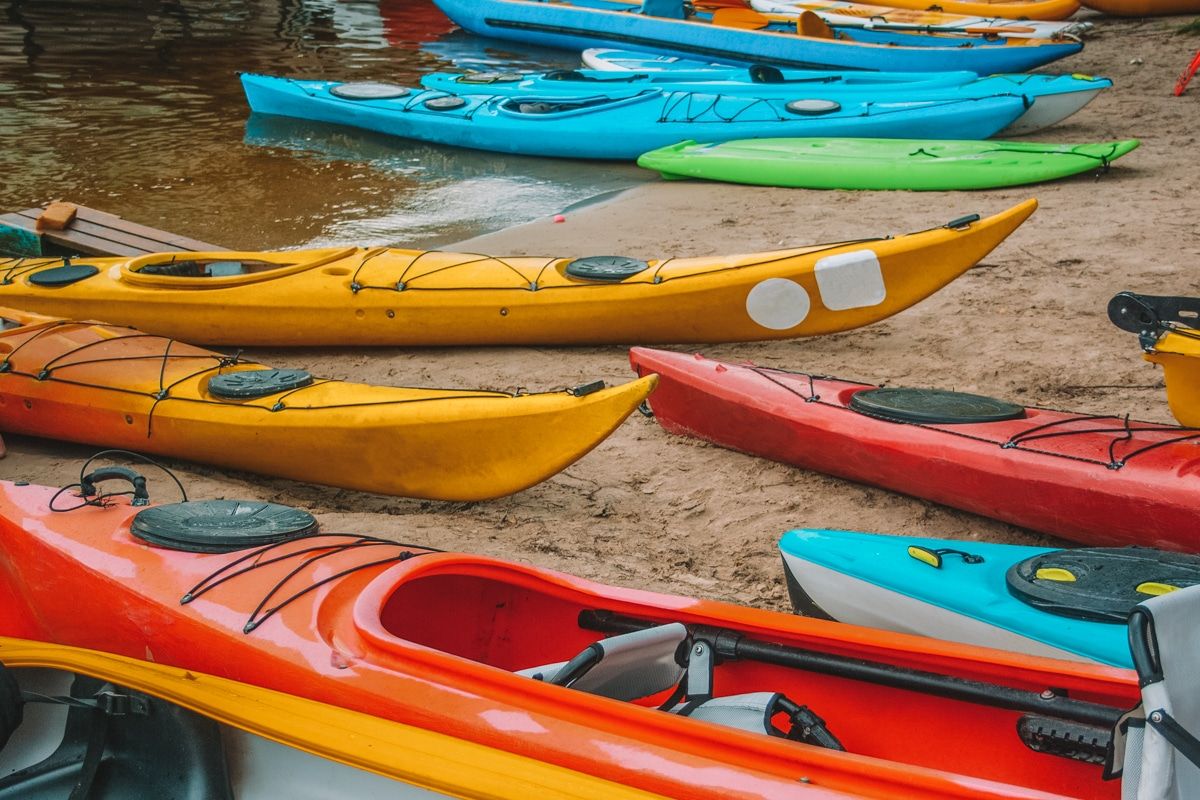
Sit on Top Vs. Sit Inside
Sit-on-top kayaks have an open cockpit (which you sit on top of–genius, right?), whereas a sit-inside kayak has a closed cockpit with a spray skirt over the opening.
Sit-on-top kayaks tend to be more stable than sit-inside models and are good beginner boats.
Solo Vs. Tandem
This distinction is self-explanatory. A solo kayak will only fit one paddler, whereas a tandem kayak will fit two or three.
Solo paddling tends to be faster than having a paddling partner, despite the double paddles.
Whitewater
Whitewater kayaks are exceptionally maneuverable as the paddler needs to dodge rocks and logs at a quick clip.
Whitewater kayaks are short, usually around six feet long, with wide hulls and rounded noses. They have more rocker than recreational kayaks, which means the bottom of the boat curves up at the front.
Surf
Surf kayaking is a new sport that uses a small kayak to surf, just like you would on a surfboard. It sounds like a lot of fun, personally.
Because surf kayaking requires lots of tight maneuvering, surf kayaks are similar to whitewater kayaks.
The main difference is that they’re usually fiberglass (not plastic), and they have even more rocker than whitewater models.
Recreational
Most kayaks are classified as recreational kayaks.
Recreational kayaks are general, all-use kayaks perfect for new paddlers. Their best use is on slow-moving rivers and calm waters. They vary in length from 8 to 13 feet long and have a variety of accessories.
Touring
Touring kayaks are also called sea kayaks, ocean kayaks, or expedition kayaks. These boats are for multi-day trips, often along the coastline, although they do great on flat lakes too.
These kayaks are long (~14-19’) and slender, which allows them to move over long distances efficiently.
Touring kayaks should be very comfortable and have lots of room for camping equipment.
Racing
Racing kayaks are a niche *niche* category of kayaks. Kayaks designed for speed and nothing else are racing kayaks.
Racing kayaks are incredibly long and thin and usually quite expensive.
Fishing
A fishing kayak has built-in fishing rod holders, enclosed storage wells, and cooler platforms, among other fishing-specific accouterments.
I often see these as sit-on-top kayaks with wide, stable hulls.
Looking for specific recommendations? Read our complete guide to the best kayak brands.
Types of Canoes
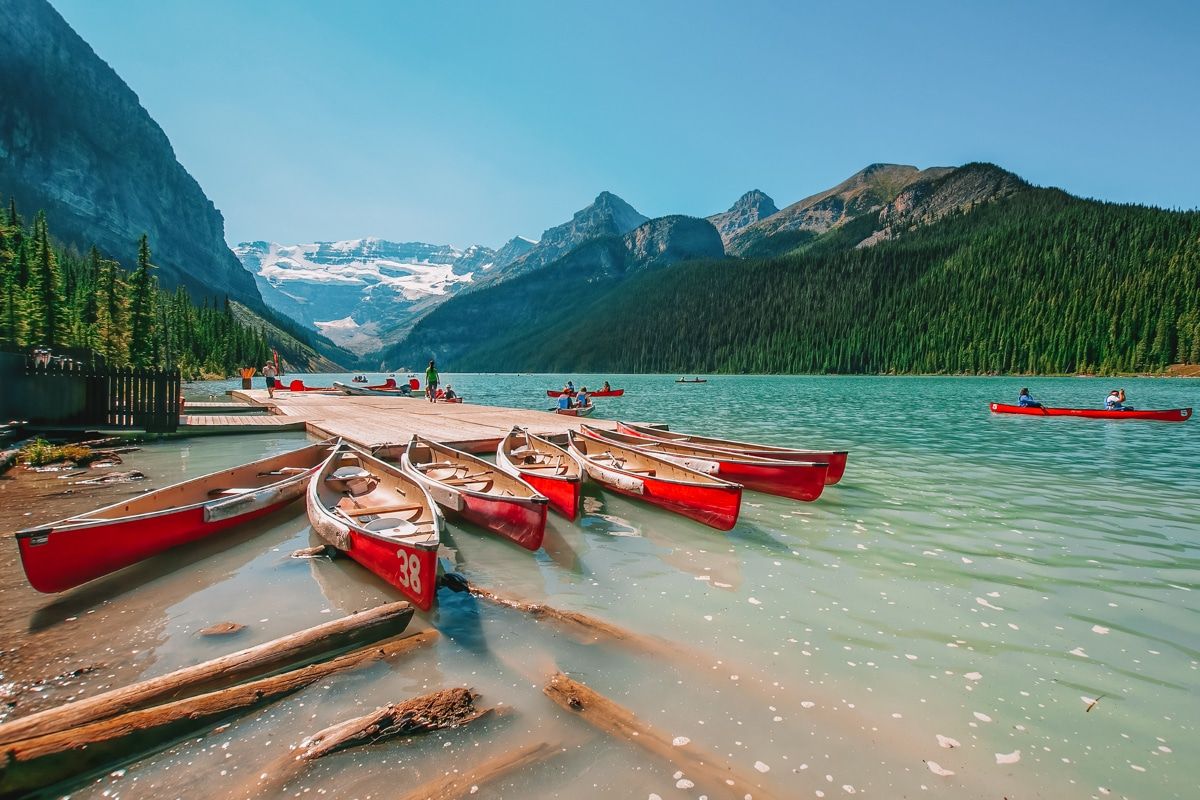
Solo vs. Tandem
Just as with kayaks, you can have solo or tandem canoes. Tandem canoes are more popular, as moving a big boat is easier if you’re not paddling solo.
Whitewater
Yes, there is such a thing as whitewater canoes!
Aside from the open-top design that all canoes have, they are similar to whitewater kayaks in that they are short, have rounded ends, and often have more rocker than recreational canoes.
These models are likely to be solo canoes.
Recreational
Recreational canoes are your classic canoes, paddled with a single-blade paddle. Recreational canoes typically fit two people and are usually 16-17 feet long.
Touring
Touring canoes are also called expedition canoes. These are analogous to the touring kayak. They’re usually at least 17 feet long and the perfect choice for a multi-day canoe trip.
Racing
Racing canoes are narrow and long boats built for solo or duo racing. Like their kayak counterparts, racing canoes are niche, expensive rowing boats primarily used in competitions.
Fishing
Fishing canoes come equipped with fishing-specific accessories like rod holders. Most canoe designs are already big enough for the other gear fishermen may have (coolers, buckets for fish, etc.)
Kayak and Canoe Materials
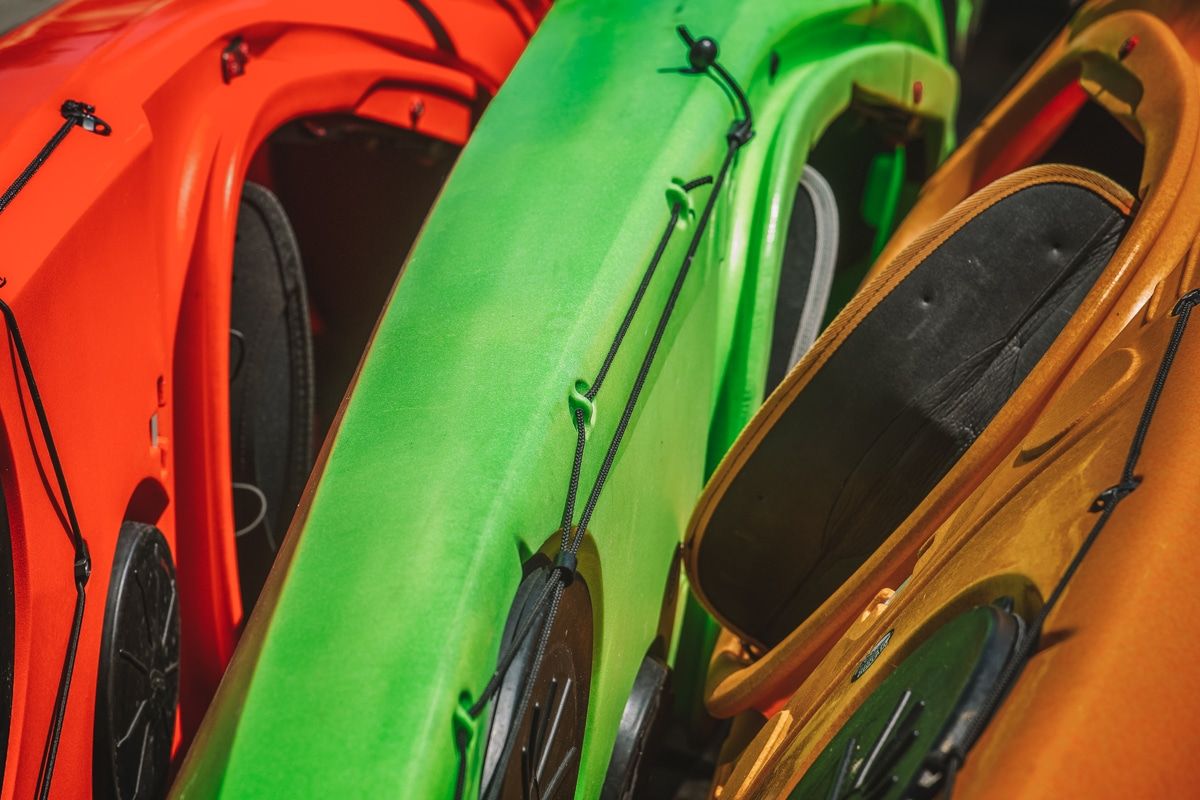
I’d be remiss if I didn’t say a word about materials. By and large, kayaks and canoes use similar materials, with some nuances.
Inflatable
Inflatable kayaks and canoes are gaining popularity. These can be solo or tandem, sit inside or sit-on-top and come in various lengths.
Inflatable kayaks and canoes are typically polyvinyl chloride (PVC). Usually, inflatable boats have a few layers of PVC for extra durability.
These boats usually feature a drop-stitch design which makes the boat’s body as rigid as a traditional hard-sided vessel.
Folding (Modular)
Folding kayaks/canoes, also called origami kayaks/canoes, are usually made of polyethylene or polypropylene plastic, which is very sturdy and forms a hard-sided hull.
Hard-Sided
- Wood: Most wooden kayaks are DIY projects, so this isn’t a common material for kayaks, but it is pretty standard for canoes. Wooden canoes and kayaks are covered in resin or varnish, making them as strong as any synthetic material.
- Aluminum: Aluminum is a popular canoe material, but you won’t see aluminum kayaks. Aluminum is durable and requires little maintenance but isn’t the fastest material.
- Rotomolded: Rotomolded kayaks and canoes are a single piece of (usually) polyethylene plastic melted into a mold. These boats are durable and less expensive than wood or composite paddle craft. You’ll often see recreational kayaks made of polyethylene.
- Composite: Composite kayaks might be fiberglass, Kevlar (aramid fabric), and/or graphite. Many boats have two or more fabrics layered together and formed against a mold. These boats are expensive but are considered the fastest kayaks, which is why they’re the materials of choice for kayak pros.
Pros and Cons of Kayaks
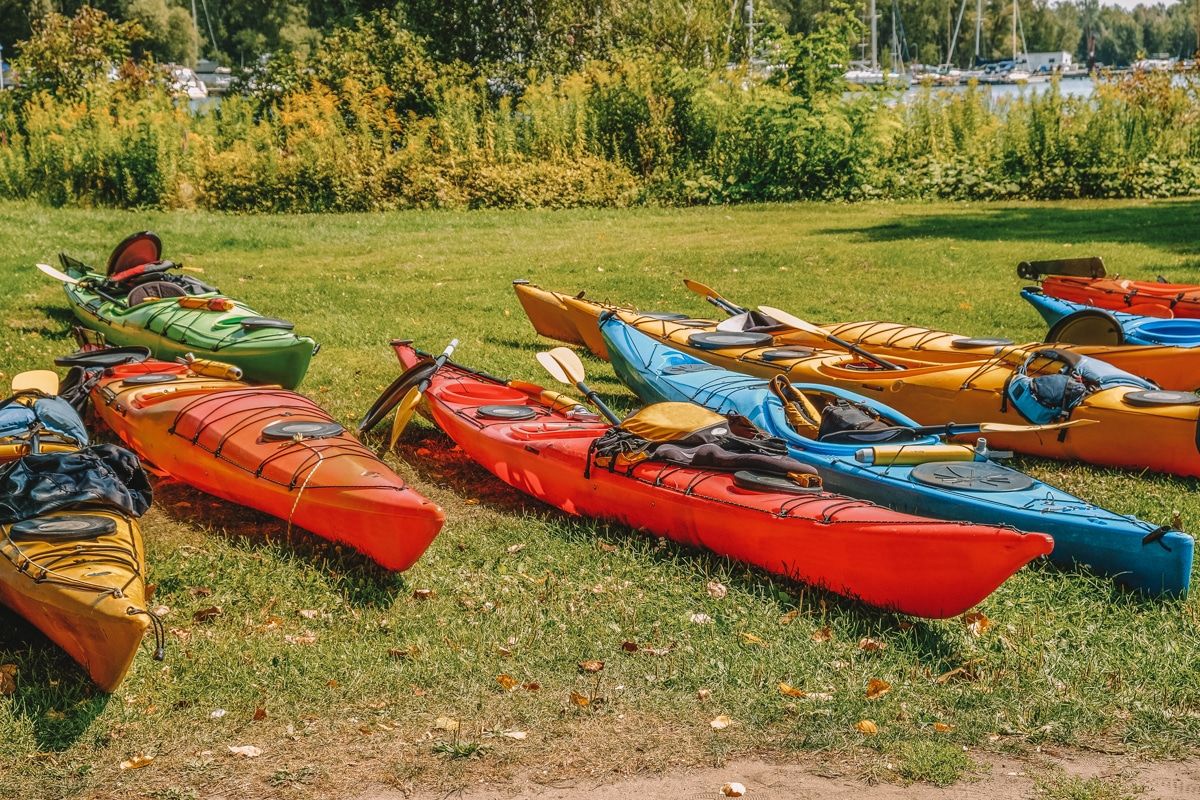
Again, remember that these pros and cons are general!
Pros
- Lightweight: In general, kayaks are lighter than canoes and, therefore, easier to transport.
- Faster: Kayaks are generally faster than canoes due to their efficient design.
- Easier to paddle: Sitting lower in the water with a sleeker design, kayaks are easier to paddle than canoes.
- More maneuverable in the water: It’s easier to turn kayaks.
- Option for spray skirt (sit-inside kayaks): This option allows you and your gear to stay dry and warm.
- Better back support: Most kayak seats have better back support than canoe benches.
- Cheaper: Overall, kayaks are more affordable.
Cons
- Less stable in the water: Kayaks are less stable than canoes due to their narrower shape.
- Lower weight capacity: Since kayaks are smaller, they usually have a slightly lower weight capacity than canoes.
- Harder to get in and out of: clambering in and out of a kayak can be an awkward process.
- Less storage space: Kayaks won’t have as much room for gear as canoes.
Pros and Cons of Canoes
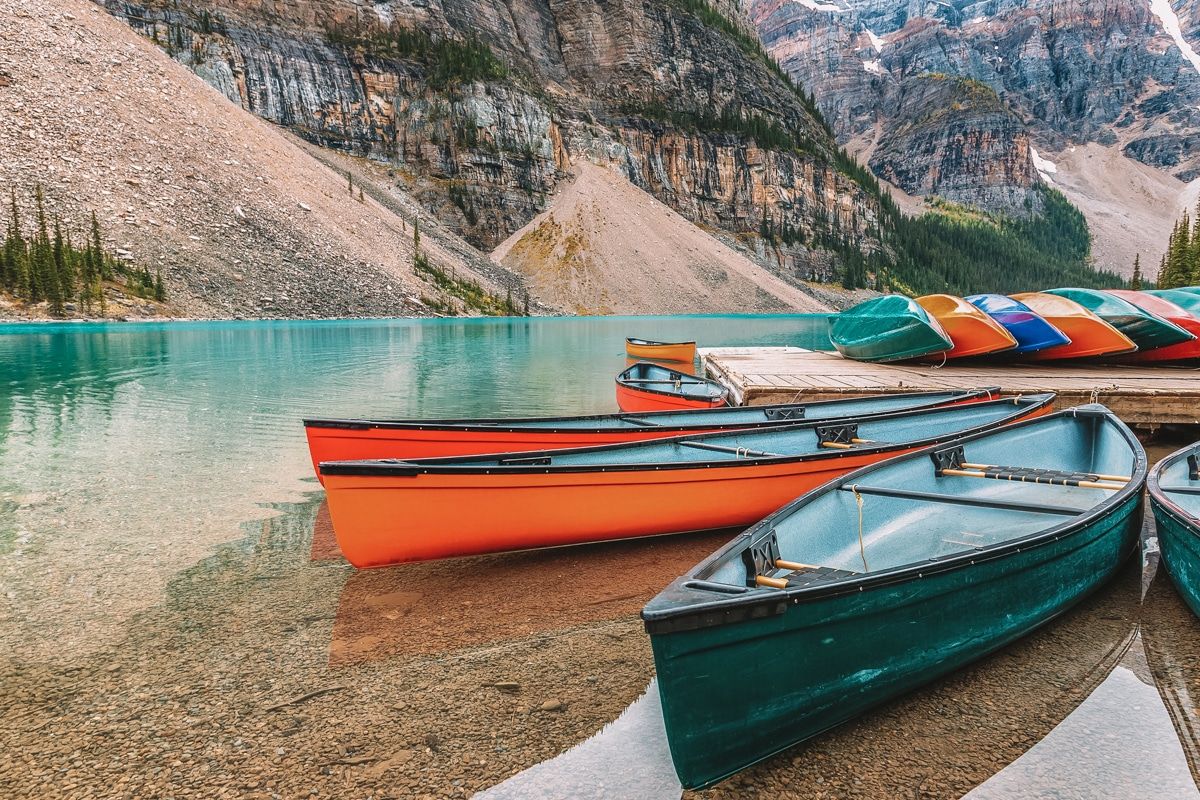
Pros
- More stable: Due to their wider shape, canoes are more stable than kayaks.
- Higher weight capacity: You can carry more camping equipment with a canoe.
- Easier to enter and exit: Simple, just step in and out.
Cons
- More difficult to paddle: Due to the size of canoes, they are harder to paddle than kayaks.
- Less maneuverable in the water: Canoes are broader and more cumbersome in the water.
- Heavier: And more difficult to transport.
- More expensive: Canoes tend to be more costly than kayaks.
What to Ask Yourself When Deciding Between a Canoe vs. Kayak
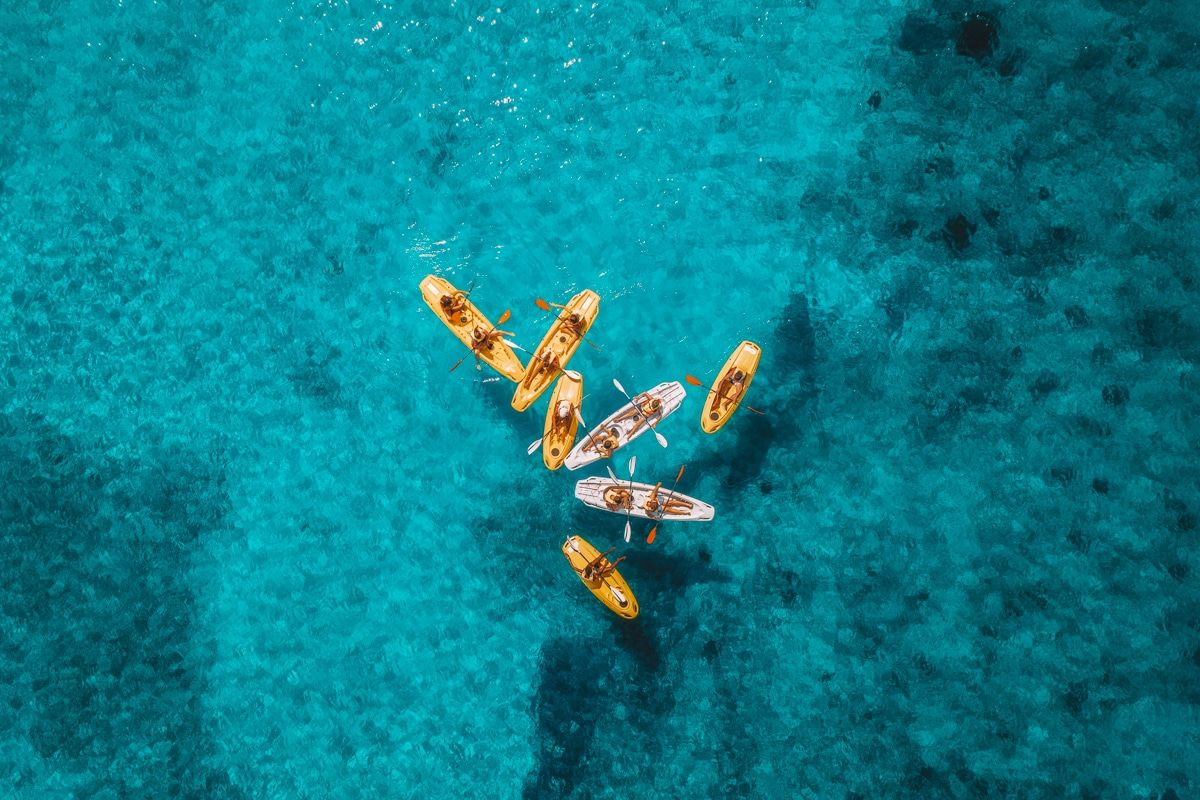
What’s My Budget?
One of the most important considerations about the canoe vs. kayak dilemma is how much you’re willing to spend.
If your budget is tight, you may want to consider a rotomolded kayak, which is durable but affordable.
What Type of Adventures Do I Like?
Once you’ve got a budget, you should consider what types of adventures you like.
Do you want a laid-back day on the local lake, or are you looking to chart new territory along a wild coastline?
Consider a canoe if easy paddling with many creature comforts is your jam. You can pack tons o’ snacks/drinks/games and have room to stretch out.
If you’re looking for a long-distance trip, I’d look into a touring or sea kayak with an efficient design.
Will I Paddle Solo or with a Partner?
You could choose a canoe if you have the luxury of a willing partner or a captive family.
Canoes are bigger and tend to be heavier than kayaks, but it’s easier to transport or portage a canoe with many hands.
If you’re ridin’ solo, as Jason Derulo says, get a kayak.
How Will I Transport My Boat?
Driving a kayak or canoe down the highway ain’t no small thing. If you have a smaller vehicle without crossbars on the top, I’d consider an inflatable kayak that packs down to a duffel bag size.
If space isn’t an issue, you could buy a hard-sided kayak or canoe.
Why Are Kayaks More Popular Than Canoes?

Kayaks are more popular than canoes because they’re easier to master for beginners. They’re easier to paddle solo and are lighter and faster in the water.
That said, kayaks don’t trump canoes in every situation. If wind and waves come to play, it can be much easier to navigate with a bigger, more stable canoe with two paddlers.
Kayak vs. Canoe: Which One is Better?
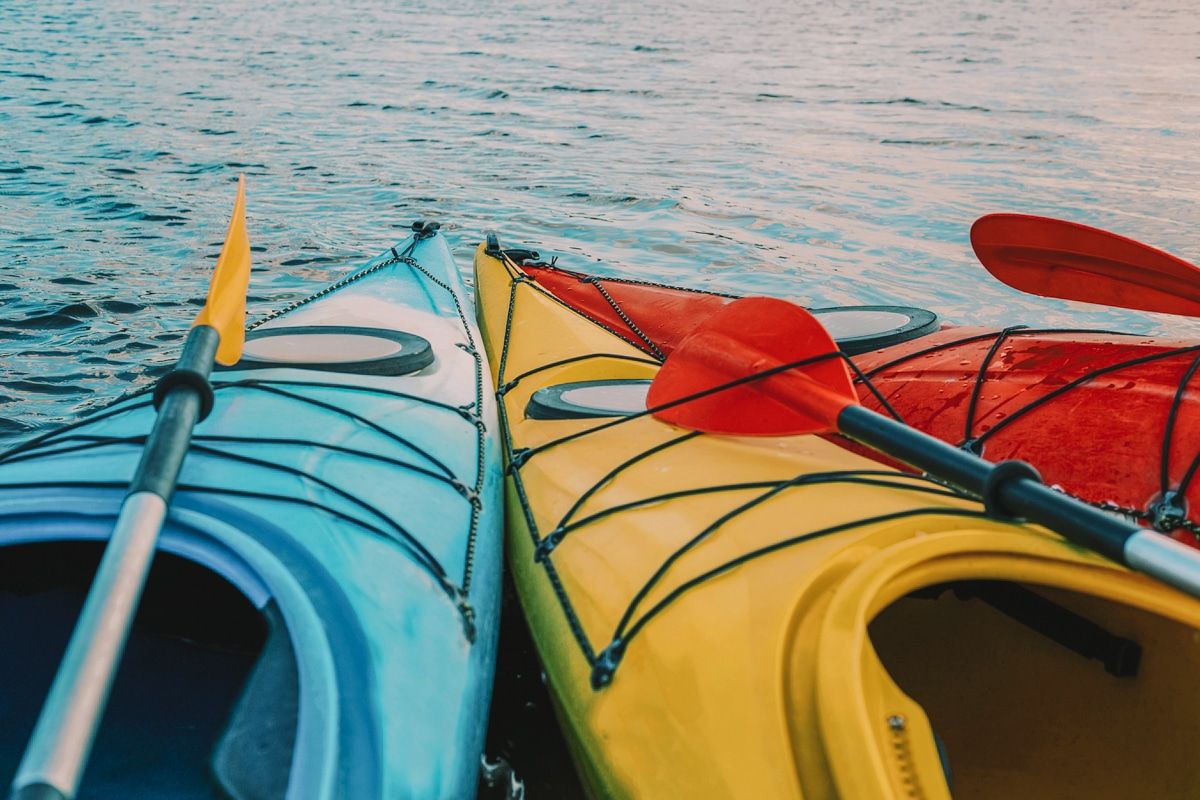
Given their ease of use for beginners and their versatility, I prefer a kayak over a canoe.
Kayaks are smaller than canoes and it’s easier to transport kayaks, plus they are easier to paddle for a solo paddler.
Canoe vs. Kayak for Fishing
As a fishing vessel, I would choose a canoe. Canoes offer more options for seating choices.
Say you want to turn your face out of the sun but don’t want to spook the fish. With a canoe, this would be easy, but with a kayak, it’d be impossible.
Canoes offer higher weight capacities, too, so you can bring tons of gear and food on your fishing trip.
Canoe vs. Kayak for Family
For a family outing, I would choose a canoe. Recreational canoes are stable and are easier to get into and out of than kayaks, which makes them great for little kids and grandparents.
Canoe vs. Kayak for Camping
I would choose a canoe over a kayak for an overnight camping trip. Canoes have tons of storage space.
The last time I went camping in a canoe, it was like glamping because I could bring all my creature comforts.
Canoe vs. Kayak for Beginners
When it comes to newbies on the water, kayaks rule. Kayaks are easier to master with little instruction, and sit-on-top designs are very stable.
Canoe vs. Kayak for Speed
Kayak speed is usually better than canoe speed because kayaks are slimmer, smaller, and easier to move.
ABOUT THE AUTHOR

Meredith Dennis
Meredith is a biologist and writer based in California’s Sierra Nevada. She has lived in 6 states as a biologist, so her intel on hiking and camping is chef’s kiss next level. One of her earliest camping memories was being too scared to find a bathroom at night on a family camping trip. Thankfully, she’s come a long way since then and she can help you get there too!
Interested in all things related to paddling? Check out these related articles below!
Best Water Shoes for Kayaking & Canoeing
Best Gifts for Kayakers and Canoeists
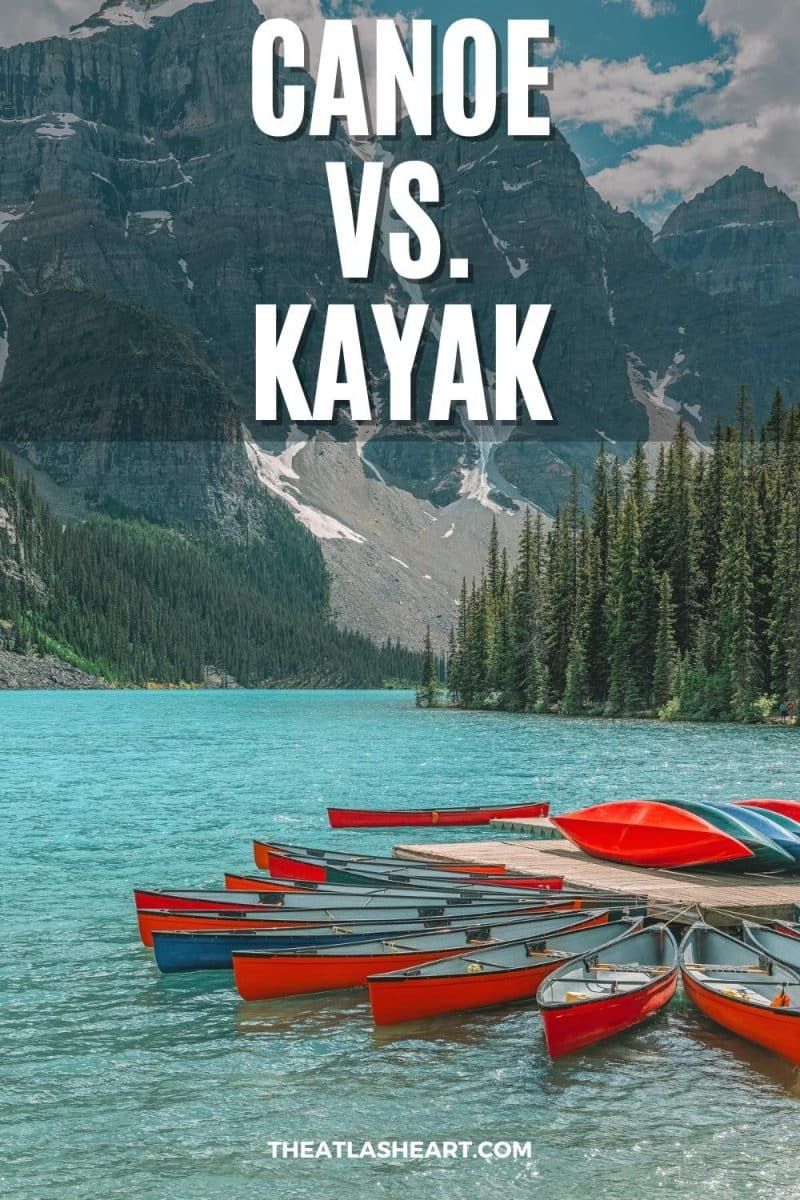
Pin this image for future reference


